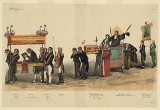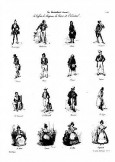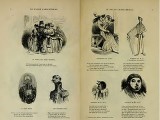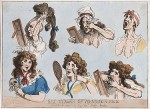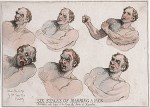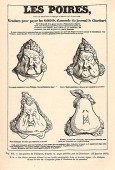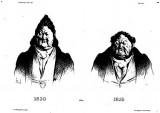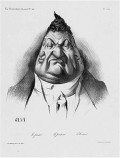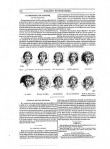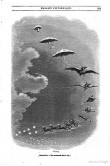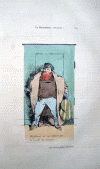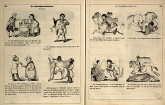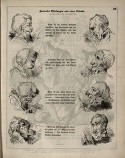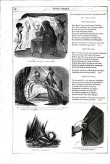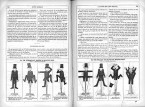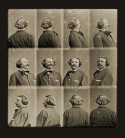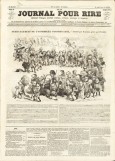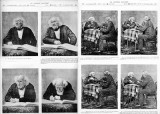The browser will either open the file, download it, or display a dialog.
The revolution of 1830, like all revolutions, occasioned a positive fever of caricature. For caricaturists, those were truly halcyon days. . . . It is a real curiosity today to look through that vast gallery of historical clowning which went by the name of La Caricature—that great series of comic archives to which every artist of any consequence brought his quota. It is a hurly-burly, a farrago.
— Charles Baudelaire[1]
If, as Baudelaire reminisced, the French revolution of 1830 caused caricature fever, such effervescence lasted well after Charles X’s downfall and through the following revolution eighteen years later. As a matter of fact, the unprecedented proliferation of cartoons stemmed as much from technology as from politics. Newfound flexibility in image reproduction and page layout kept fueling a sense of excitement in the publishing industry throughout the July Monarchy. Some of the formats devised to combine words and pictures have waned; others have become standard; one of them, the comic strip, would bloom during the following century. Among its pioneers stood one of Baudelaire’s closest friends,[2] Félix Tournachon (1820–1910), alias Nadar, destined to become nineteenth-century France’s most famous photographer.
As the 1830s came to a close, young Tournachon made his début as contributor to any periodical willing to give him a chance, first in Lyon, then in Paris.[3] Alternatively freelance columnist, serial novelist, and chief editor of an aborted literary magazine, the bohemian journalist displayed a formidable enterprising energy that quickly made him an omnipresent player in Parisian artistic circles. Still, in spite of the wide esteem he earned throughout the city, financial success and public recognition remained a long time coming. Hence, the late 40s saw Tournachon—then going by Nadard[4]—gradually giving up his aspiration to make it as a novelist and strategically redeploying his skills as communicator. In the space of four years he refocused his writing around columns and biography while diversifying his mediums of expression: the satirical cartoon, the comic strip—still a novelty at the time—and finally, photography, the great medium in development that would define his legacy.
I propose here to take a look at both Nadar’s pictorial work and the early comic strip from a historical perspective framed by the multiplication of the serial image. By serial image, I mean, series of vignettes forming a narrative (sequential images) or series of single pictures forming a collection around a same theme over several pages or issues of a publication (panoramic images). This overview has a double aim. One is to outline an area of Nadar’s activity that usually gets only partial scholarly treatment because of its cross-platform nature: his experiments with the sequential image. Nadar played with graphic narratives and chronological photography at different points in his career. These efforts remained sporadic and spread out over several decades. Yet, beyond their documentary value, as I suggest, they lend an insight into both the history of the comic strip and Nadar’s outlook on the image as a whole. They are emblematic of a tension between two axes of nineteenth-century culture: the sequential, whose manifestations put the comic strip in league with the serial novel and the kinetoscope, and the panoramic, understood since Walter Benjamin as uniting dioramas, studies of manners, and universal exhibitions.[5] To better understand Nadar’s approach to cartooning, it seems appropriate to place the early comic strip within its native ecosystem of thriving serial-image forms competing for the urban literate’s attention. Thus, the first half of the article also aims to detail some of the related graphic species that accompanied the emergence of the comic strip, from the classic gallery of caricatures to the ephemeral flip-print micro-narrative. In spite of a rich variety, the sequential image remained a minor segment of imagery in a century that embraced all things panoramic.
This study may complement two compelling Nineteenth-Century Art Worldwide articles by Patricia Mainardi. “The Invention of Comics,”[6] made the point that the comic strip’s visual conventions were invented gradually, and surveyed their evolution from Rodolphe Töpffer (1799–1846) to Cham (1818–79) to Gustave Doré (1832–83) during the 1830s-1850s period. Nadar was the third French practitioner of the new narrative art to make more than a passing impression on the public. Both perspectives drawn here ultimately mark his storytelling as independent from the Töpfferian model. In the process, they highlight the multiple roots of the comic strip and its position within a dense family tree of pictorial forms that connects such disparate species as artist studies of facial expressions and the motion picture. Mainardi explored the painting and broadsheet connections in that network in a subsequent essay,[7] and the approach developed here seeks to further map out the subject.
Prevalence of the Panoramic Perspective
The comic strip is a popular art of the “I know it when I see it” variety; the diversity of its forms has always made it a problematic cultural object to define. Even the double consensus on its disputed nature and origins that sealed its cultural status as a subject of academic investigation in the late twentieth century is a paradox in itself. It holds that the sequence is the basic building block of the protean narrative form to the exclusion of any of its other features (figures, text, speech bubbles, frames, layout, etc.) and that the pivotal figure in the evolution of pictorial narratives in Europe was Rodolphe Töpffer, schoolteacher and first professor of rhetoric at the Academy of Geneva.[8] In the late 1820s Töpffer brought together the book and the fragmented-page format of short stories in vignettes found in broadsheets and English satirical periodicals.[9] His comic books/graphic novels (both terms equally apply to his stories) for educated readers featured the most developed stories in captioned drawings to date.[10] Töpffer instituted the strip as the basic graphic-narrative syntagma and introduced comedy of manners and slapstick humor in a domain traditionally dominated by moralizing tales and political satire. Besides combining and tweaking existing models, Töpffer also broke new ground by modulating the width and frequency of individual panels within strips to create unprecedented effects of rhythm, visual rhyme, and synecdoche in pictorial storytelling.[11] Töpffer himself considered that he had invented a novel narrative form, and went so far as to theorize his creation, most extensively in a short, idiosyncratic treatise entitled Essay on Physiognomy in 1845, the year that preceded his premature death. Designed at a time when semiotics still was in its infancy, his pioneering approach to cartooning as a system of signs took roughly a century to click with literary studies, but click it did. The irony of this tight fit, however, lies in that Töpffer’s pre-linguistic theory barely concerns itself with the articulation of signs in time. Indeed, the focus of our modern semiotic perspective on his work may very well surprise the professor himself. His theoretical work—possibly uncompleted at his death—approaches the very central notion of sequence only implicitly. Focused on satirical character design, it rather understates the narrative dimension of his system and instead flaunts its reliance on paradigmatic galleries of facial features and expressions similar to those found, a quarter of a century earlier, in his compatriot Johann Kaspar Lavater’s (1741–1801) widely influential treatises on physiognomy. In essence, it reflects the modernity of its time: its century’s growing love affair with panoramic outlooks.
Indeed, a clear synergy linked the proliferation of the printed image, widespread interest in physiognomy and caricature, the development of studies of manners dubbed “physiologies,” and the birth of the magazine, all wrapped up in new relationships between word and image. Charles Philipon (1800–62) framed an entire segment of modern visual culture in that regard. La Silhouette and La Caricature, the first illustrated periodicals in France and starting points of his journalistic career in the late 20s, featured short stories by Honoré de Balzac prefiguring his Human Comedy, mother of all literary overviews of society. With a marketing plan based on making pictorial albums of all kinds more affordable, as an ad would remind readers in 1852,[12] Philipon created the first comic-book collection in 1839 around pirated Töpffer titles originally published in Geneva, and published half of the illustrated physiologies on record throughout the 40s.[13] Töpffer’s Parisian cousin Jacques-Julien Dubochet (1798–1868) co-founded L’Illustration (1843), the second (lavishly illustrated) educational magazine created in France after the Magasin pittoresque (1833).[14] L’Illustration would be the first periodical to open its pages to storytelling in drawn strips in 1845, giving the serial novel a pictorial turn with Töpffer’s Aventures de M. Cryptogame (1830–45), specially re-drawn for wood engraving by his first follower, Cham.[15] Dubochet had also produced the first illustrated edition of the Human Comedy in 1841, in partnership with Pierre-Jules Hetzel (1814–86), himself future facilitator of Nadar’s stint as comic strip artist.
Meanwhile, as early as 1831, the oversized lithographs inserted in the weekly Caricature happened to take on panoramic dimensions that distinguished them from run-of-the-mill satirical allegory. They deployed their characters along two distinct axes: either in space, as caricatural parades of personalities or types (fig. 1) or over time, as series of individual portraits to collect issue after issue. Star illustrators J. J. Grandville (1803–47) and Paul Gavarni (1804–66) made a specialty of composing group scenes with such titles as Le carnaval politique (Political carnival), La procession du diable (The devil’s procession), and Grande ménagerie politique et monarchique (Great political and monarchist menagerie).[16] Honoré Daumier (1808–79), on the other hand, built up his own panoramas week after week. Well served by his trademark textured rendering of shading and volumes, his caricatures of politicians and contemporary types rapidly established him as master of the genre.[17] His career took a new turn with a variation, co-authored by Philipon, on existing models of satirical panoramas: a survey of urban daily life over 101 prints of a single character’s wheelings and dealings, swindler archetype Robert Macaire. The series originally appeared from 1836 to 1838 in Le Charivari, Philipon’s next venture, where Gavarni regularly published studies in vignettes of another modern archetype, the urban young courtesan known as a lorette.
Meanwhile, treading a middle way between panoptic scenes and portraits, La Caricature laid out entire galleries of types in that smaller format. Artists like Eugène Forest (1808–91), Victor Adam (1801–86), and Alophe Menut (1812–83) divided their pages into individual vignettes, up to sixteen images in tabular disposition, broadsheet-like (fig. 2). Detailing variations in costume and fashion accessories across socio-cultural groups or historical eras, these segmented plates formed visual ethnological surveys of sorts that paralleled and complemented the societal nomenclatures of physiologies.[18] Whenever these series of images happen to have a historical dimension, they illustrate a progression without truly focusing on linearity. Merely serving as thematic principle, chronology is often more approximate than historically correct, and the vignettes on any given page could be reordered without ruining the display of diversity that underlies them.
Among non-sequential juxtapositions of images, a new genre made a splash in the early 40s, rendered popular by Bertall (1820–82), another famed illustrator of his time: the Salon.[19] It consisted of a tongue-in-cheek review of the yearly Parisian fine-arts Salon de l’Académie des Beaux-Arts in captioned images, with the caricature operating at both the pictorial and verbal levels (fig. 3). This formula suited Cham so well that the success of his own salons, destined to last until his death in 1879, single-handedly came to elevate the very status of cartoonists, according to Kunzle, who, in The Early Comic Strip, tells us that Cham’s pages of vignettes acquired unprecedented popular recognition, even surpassing that of Daumier’s lithographs.[20] With public demand for such comical reviews consequently exceeding the frequency of existing exhibitions, visual satirists soon turned to current events as an endless source of subjects. Starting in 1848, Cham held his own Revue comique de la semaine (Week in review) in Le Charivari. Such was the success of these tongue-in-cheek surveys that he would eventually give up the comic strip, the genre that had formed him as artist, to focus exclusively on non-sequential ensembles. More than a mere trend, panoramic series of images were a facet of a full-blown cultural paradigm that Kunzle evokes in the following terms:
The miscellany review of the week, month, or year, copied by journals throughout France and in other countries, especially Italy, represents an innovation of considerable significance in the history of illustrated journalism and caricature. It evidently satisfied demands for a variety, topicality, modernité in a way traditional series of social types, à la Daumier and Gavarni, could not. It offered multiplicity and comprehensiveness, a full sense of what was going on at different social and political levels, much as did the new “encyclopedic” illustrated news journal L’Illustration (significantly subtitled “Journal universel”). As a cultural characteristic of the 1850s and 1860s, such topicality, variety and multiplicity could be a matter for extended analysis. [Nineteenth-century historian of caricature John] Grand-Carteret, sensing the significance of Cham’s innovation, points vaguely to a change that had taken place in the 1830s and ’40s: “Customs and ideas slowly changing by the force of events, a daily paper was no longer to be maintained just with studies and sketches.”[21]
This is also precisely the direction that Nadar’s caricature would take after his efforts in sequential art. The non-narrative survey and its cousin species, the macédoine, (half) page of cartoons on loosely related subjects, remained the most common type of captioned vignettes in France until the late 1880s, when the tide started turning in favor of the comic strip. Until then, the future neuvième art (ninth art)[22] only occasionally stood out among a rich variety of image/text combinations and made a smaller blip on the century’s cultural radar than physiologies, salons, and panthéons of personalities. So much so, in fact, that the French language would not have a name to distinguish the bande dessinée (drawn strip) from any other form of cartooning, globally referred to as caricature, until the next century. Designations proposed by Töpffer and Philipon[23] did not take, and the two pioneers in text/image interaction embody, each in his own way, the pull between the sequential image and the panoramic image that frames Nadar’s approach to the comic strip.
Micro-narratives and Time Lapse
A second paradox surrounds Töpffer’s approach to storytelling: the father of the comic strip kept his têtes d’expression (studies of facial expressions) as paradigmatic tools of preparatory study, devoid of any chronological linearity, while time-lapse rendering of physiognomies and states of mind had become a popular stylistic exercise among sequential-art experimenters uncelebrated as such today. Lavater himself had played with sequential images to illustrate morphological similarities between such distant biological species as a frog and a human being, and Grand-Carteret credits him as the inspiration of such physiognomic gradations to caricaturists.[24] In Britain, Thomas Rowlandson (1756–1827), for one, had experimented with sequential portraits a couple of decades before his Dr. Syntax series of illustrated books (1812–21), which Töpffer claimed as an influence on his own pictorial storytelling. In 1792 the English caricaturist had published a dual set of watercolor prints, each figuring a different type of physiognomic transformation in six images over two rows on a horizontal page. Six Stages of Mending a Face (fig. 4) turns an uncomely lady into a ravishing damsel through a series of prosthetic and cosmetic enhancements, while Six Stages of Marring a Face follows an inverse progression in a pugilist’s face, detailing his gradual disfigurement during an unfavorable match (fig. 5). United in theme and symmetrical in effect and gender, the two series of images differ in their linearity. Oddly indeed, neither of these sequences “reads” in Western standard direction (i.e., 1-2-3/4-5-6) nor like each other. The various phases of the processes depicted in Mending unfold clockwise (i.e., 1-2-3/6-5-4) while Marring reads right to left all the way through (i.e., 3-2-1/6-5-4). This inconsistent pictorial syntax, surprisingly contrasting with the alignment of the plates’ paratexts of two-dozen words each,[25] suggests that this may have been an isolated exercise for Rowlandson. Kunzle’s The Early Comic Strip showcases examples of turn-of-the-19th century British satirical time-lapse physiognomies.[26] Within a “biographical continuity” perspective, so-called progress prints reverse the usual outlook on archetypes and real-life figures such as John Bull and Bonaparte. Twisting the rise-and-fall model favored by William Hogarth’s moralizing sequential tableaux, such as A Harlot’s Progress (1731) and Marriage à-la-mode (1743–45) earlier in the century, they tell their stories through a character’s changes in appearance instead of representing the events that cause them.
Amusing examples of time lapse in France include an 1830 pseudo-medical illustrated book plotting out physical degradation. With sixteen vignettes spread out over 118 pocketsize pages, Le livre sans titre (The book without a title),[27] an eminently didactic work by an anonymous “prison administrator,” professes “the means of correcting young inmates from onanistic habits.”[28] At the pace of every four to five pages, its images depict the gradual demise of a seventeen year-old boy ultimately killed by his vice, emaciated, toothless, and covered in pustules.[29] The next year, Töpffer received a letter from no less than Goethe himself, encouraging him to publish his first graphic novels, and Philipon drew the first French satirical sequential physiognomy, a milestone in French caricature, the four-stage morphing of Louis-Philippe into a pear (fig. 6), an image that the monarch would never be able to shake off.[30] Without producing any developed narratives à la Töpffer, La Caricature embraced the sequential more than any other 1830s periodical in the country. In its pages, Daumier, for one, experimented with transformations of Louis-Philippe’s figure at least twice. Barely a year after his release from prison for his famous gargantuan rendition of the so-called Citizen King, he now seemed to delight in compressing his silhouette. First, a metonymic 1830 et 1833–Ravages opérés par les soucis du trône sur les augustes bajoues de notre auguste monarque (1830 and 1833–Ravages caused by the worries of a king on the august jowls of our august monarch) assessed the downward popularity of his reign through a deflated demeanor (fig. 7). Daumier went further with a creative Le passé. Le présent. L’avenir (The past; the present; the future)[31] that condenses biographical continuity into one grotesque multi-faced entity with increasingly acrimonious facial expressions (fig. 8).
Grandville introduced real time and psychological drama to sequential physiognomy in a one-off micro-narrative that reads like a cinematic sequence. During the last years preceding his own untimely demise, a few months after Töpffer’s, he produced a number of time lapses for the Magasin pittoresque. The first of them, Monologue de Baptiste (Baptist’s monolog) (fig. 9), is a pantomime that takes its character from worry to fear to relief in ten captioned stages united in one frame. A nearly 400-word-long introduction[32] weighs down its narrative fluidity with a debatably superfluous back-story and justification for the artist’s linear organization of attitudes. Just like the inconsistent sequential direction in Rowlandson’s watercolors, the drawn-out explanation implies novelty and a certain discomfort towards pictorial sequences on the part of a magazine that made ekphrasis a journalistic genre in France. It reveals the stylistic exercise for what is, on the part of a leading illustrator with a marked taste for metamorphoses, anamorphic bodies, and anthropomorphic animals. Without a satirical or moralizing intent, the scene has no other pretext, in the full sense of the term, than interest in exploring possibilities offered by the sequential image.
Each of Grandville’s subsequent experiments in representing visual progressions worked out a distinct approach. In 1843, two Lavater-esque symmetrical outlooks on moral decay and intelligence development appeared over a double page in the Magasin pittoresque. L’homme descend vers la brute (Man descending into animality) depicts a criminal’s lifespan in five portraits spiraling down from innocent child to weathered convict. Its parallel image, L’animal s’élève vers l’homme (Animal rising toward humanity) is an ascending but rather far-fetched suite of as many dogs’ “faces” with increasingly human looks in their eyes, from blank-slate pup to bespectacled exhibition dog.[33] Presented as Grandville’s last drawings,”[34] his next sequences, published three months after his death in 1847, further split his treatment of gradation in different directions, each depicting a different type of dream. One, a pre-surrealistic piece entitled Crime et expiation, expresses an anguish characteristic of his later work. It articulates a series of symbols zigzagging down the page into a “tormented man’s nightmare” plot decrypted in the author’s 500-word companion piece. The other, Une promenade dans le ciel (A stroll in the sky) is a gentler fantasy showing a full-fledged metamorphosis from mushroom to fireplace bellows to star constellation in nine stages (fig. 10). It prefigured Grandville’s two object-to-animal/object-to-human transformation plates reproduced in the fourth edition of Hetzel’s panoramic collection of texts and etchings: Le diable à Paris–Paris et les Parisiens.[35] A few months later, in 1848, the Magasin pittoresque continued on the moralistic path with a split physiognomic plate by Bertall. Entitled Influence de la moralité ou de l’immoralité sur la physionomie[36] (Influence of morality or immorality on physiognomy), it forks out into two possible life spans for a toddler, one following the straight and narrow to conclude on a portrait of a dignified elder, and the other, marred by vice, ending with the image of a wretched old man.[37] Remarkably, in spite of the Magasin pittoresque’s modern outlook on the image and its relationship to the word, these sporadic experiments blending transformation sequences with the paradigmatic exercise that is têtes d’expression constitute the entirety of its involvement with sequential art. Even though the magazine took enough notice of Töpffer’s work to publish serial excerpts from his Essay on Physiognomy in 1849, it would never make the step to more developed pictorial narratives, unlike other periodicals of the time.
Indeed, the various forms of sequential art evoked here were not the only ones to accompany the emergence of the comic strip. The press as a whole tried out chronological suites of pictures in all proportions with text. In the early 40s La Mode, L’Illustration,andthe Musée Philipon featured abundantly illustrated theater reviews and satirical fictions including, in the Musée’s case, a series of popular mythological and literary parodies by Cham. At the other end of the spectrum, ten years earlier, La Caricature had already made a specialty of using captioned vignettes in pared-down micro-narratives. If Philipon’s pears have remained emblematic for their daring political stance against Louis-Philippe, the very first experimentations of La Caricature with sequential images have been practically forgotten. These remote cousins of the comic strip rest on kinetic processes still found in children’s flip books today. Between 1830 and 1835, La Caricature published five so-called lithographies à système (flip prints): two-panel time lapses on a “before/after” model, also designated as planches à transformation (transformation plates). In most cases, they consisted of a paper flap fixed to the page and made to look like a door that reveals a different scene when lifted. Playing on antithesis and irony, the hidden tableau aims to create a tragicomic contrast with the first: a naïve husband and an illegitimate couple (fig. 11), the shamefully unkempt interior of a deceptively well-dressed bourgeois couple, or an allegorical Marianne unexpectedly bound and muzzled by censorship. Another type of transformation plate, dubbed planche à tiroir (drawer plate), functions by sliding a strip of paper under a frame bearing the inscription Panorama lithographique so as to make one of its two pictures coincide with the opening. In Le Bois–On y va à deux/On en revient trois[38] (In the woods–two’s company/three’s a crowd), for instance, a young couple seeking privacy outside the city walls find themselves forcefully repatriated intra muros by a gendarme (fig. 12). Destroyed by time, for the most part, these fragile cutouts and folds are precious documents for the histories of the press and of sequential art. They testify to both the migration of magic-lantern tricks to paper and to the creative effervescence that imbued the 1830s press.
Nadar’s First Bandes Dessinées
If the 1830 revolution spurred caricature fever, the 1848 cultural landscape in which Nadar made his sequential-art début encompassed multiple revolutions across Europe. One of the regions involved, Germany, was home to Fliegende Blätter, perhaps the most polished illustrated satirical magazine of the time, whose influence reached Nadar in Paris. In 1845, roughly three months after M. Cryptogame’s début in L’Illustration, the Munich periodical became host to the first recurrent character in the history of the comic strip, Franz von Pocci’s (1807–76) satirical archetype of the Teuton bureaucrat Der Staatshämorrhoidarius. Of particular interest here is the fact that the series’ first installment appeared as a panoramic ensemble without any chronological thread, like a Macaire in vignettes. Each of the two-dozen following episodes, in contrast, developed a story (fig. 13). There is no chronological arc behind the separate narratives; the series could be read in any order without damage to the cumulative effect of displaying various facets of a type. Der Staatshämorrhoidarius never went back to a mere juxtaposition of scenes and the first two pages were reworked into a linear biographical prelude for book publication. The adventures of the dull pencil pusher fanned out over images arranged in columns, according to standard press layout. This vertical-strip format and the incidental linearity of this panoramic series make Der Staatshämorrhoidarius stand out as finding its roots elsewhere than in the Töpfferian model of graphic narrative that kept informing comic-strip artists throughout the century. Even in spite of the language barrier, Nadar’s own stories in pictures would display more affinities with the Bavarian magazine’s approach to cartooning, closer to press standards that were familiar to him.
Fliegende Blätter sequential art that left an imprint on Nadar’s also includes the magazine’s first try at sequential physiognomy with an unsigned six-vignette plate entitled Der Blick in die Zukunft[39] (Looking into the future) in the fall of 1848. It stages a German monarchist reacting to the propagation of the 1848 Revolution throughout Bavaria in the course of a few days.[40] In a comical combination of increasing sullenness, dishevelment, and premature aging, his outlook becomes somber, not only figuratively but also literally, as his pompadour slumps down over his eyes. A few weeks later, the magazine took the idea of sequential news reports up a few notches with one text concurrently driving two sets of pictures. Zweierlei Wirkungen aus einer Ursache (Two different effects from the same cause)[41] illustrates how one man’s loss is another’s gain through communiqués of a counter-revolutionary victory (fig. 14). Two columns of images flank the verbal narrative on each side with diametrically opposed reactions to it. As news of the ill-fated October Vienna insurrection keeps coming in, partisans of the Hungarian revolution successively experience hope, concern, shock, and despair, while officers of the Austrian army go from angry disbelief to grateful relief in as many parallel stages. The vertical disposition of the sequences ensures that the eye registers contrasting responses at each step. With effects of comparison, antithesis, and symmetry, this second incursion of Fliegende Blätter into time-lapse têtes d’expression manages to make the most of limited possibilities. Moreover, each pantomime plays itself out through a gallery of characters rather than over a single face, in an equal blend of panoramic and sequential that would not be lost on Nadar.
His first incursion into sequential art took place the same month, in November 1848. France had the broadest comic-strip scene at the time, budding as it was. Two years after Töpffer’s death, the prolific Cham now was the champion of picture-stories. He had a dozen graphic novels under his belt, most of them with the maison Aubert, Philipon’s publishing house.[42] Nadar had found his own voice after initial phases during which his graphic style had emulated Töpffer’s and Daumier’s, respectively. Those phases also happened to be his most experimental ones, with a definite streak of humor influenced by Laurence Sterne’s The Life and Opinions of Tristram Shandy, Gentleman (1759–67).[43] He was, however, about to shed it to cultivate a more mainstream tone and give up Töpffer’s strip for layouts more in line with periodical-press standards. Cham’s fame now extended across the Atlantic[44] and he was on his way to becoming the most famous press cartoonist in France for the next thirty years. Graphic narratives only counted for half of his work, amid macédoines, salons, and the illustrated fictions written by Philipon and his team. His work was published in the Charivari, the Musée Philipon and L’Illustration. Besides the three pirated editions of Töpffer’s seven albums that had started it all, the Aubert catalogue also included a clone of Cham’s work by his occasional collaborator Forest,[45] and, more importantly, a story by Gustave Doré, future star illustrator of his century, Les Travaux d’Hercule (1847). Doré had the distinction of publishing that first book at the age of fifteen[46] and would compose three more creative graphic novels[47] before leaving satire behind for higher artistic grounds. By now, a handful more of French cartoonists had given the new narrative form a quick try: Benjamin Roubaud in L’Illustration, [Alcide Joseph] Lorentz in the Musée Philipon, and [Edmond] Morin, [Henri] Emy, and Ed. Damourette in the brand-new weekly Le Journal pour rire, where Philipon nurtured Doré’s cartooning skills. All in all, while the Aubert picture books were marketed as presents for the entire family, satirical magazines were geared towards men with disposable income. The readership of comic strips in France was very much adult and would remain so until the 80s.
Nadar drew his first strips for La Revue comique à l’usage des gens sérieux (The comical review for serious people), an iconoclastic weekly specifically created by Hetzel to counter presidential candidate Louis-Napoléon Bonaparte’s run for the presidency.[48] The virulence of the satire against the emperor’s nephew distilled by the Revue comique matched the disproportion of forces in the press. According to one estimate, newspapers in favor of Louis-Napoléon’s candidacy dominated the country’s media landscape practically by 5 to 1.[49] Within their ranks they counted public opinion stars of such different feathers as Victor Hugo and “Napoléon of the press” Emile de Girardin.[50] Nadar wore many hats on the Revue’s editorial staff of a dozen that included Gérard de Nerval and Félix Tournachon among its columnists, and Bertall and “Nadard” among its illustrators. For a political magazine, it showed remarkable taste for experimentation in word/image combinations, even in comparison with titles explicitly focused on the image. With the very term Revue reflecting the ambient panoramic perspective, Hetzel’s journal offered thematic groups of cartoons in spreads of up to seven pages between some of its articles. Dutifully credited at first, occasional pictorial borrowings from British magazines turned into shameless pirating from Punch (subtitled The London Charivari) and Fliegende Blätter throughout 1849, the last year of its run.[51] From its second issue on, thanks to Nadar, Revue comique also became the third French-language periodical to publish graphic narratives. Still a novice in that field, Nadar had no clear graphic identity yet. His early drawings lack stylistic unity, balancing between the dense hatching of his Revue collaborators and the clear line practiced by Töpffer, the early Cham, and Punch cartoonist Richard Doyle.[52] Amplified by the engraver’s intervention, this composite quality inscribes some of his images within a mismatched aesthetic of assumed awkwardness. “A bunch of little masterpieces, bizarre, crazy, absurd, and resembling a child’s drawings,”[53] is how Nadar’s necrology in 1910 in Le Livre et l’image, pioneer of “graphic language” critical studies, would remember his early pictorial offerings, largely eclipsed ever since by his accomplishments as photographer and balloonist. Alternatively “linear and disjointed,”[54] Nadar’s stories contrasted with the sustained pace found in Töpffer’s and Cham’s comedies. Without systematic linearity, the future portraitist’s comic strips alternated sequential and thematic images in a blend of storytelling and allegorical cartooning. At a time when the basic codes of the comic strip were still crystallizing, Nadar first adopted the vertical-strip format in use in Fliegende Blätter.
His first effort, a vitriolic biography of Louis-Napoléon, appeared during the November-December ‘48 presidential campaign. Throughout its 42 images in columns paced over three weekly issues, Les aventures illustrées du Prince pour rire (The illustrated adventures of the pretend Prince) ridicules the nephew of the Eagle (as Napoléon was known) as unworthy, and foreign to France’s culture (he was raised in Switzerland), and repeatedly portrays him as an ugly duckling with a stereotypical Germanic accent. “I shall crush the imperial eagle in the egg” announces an epigraph borrowed from Hugo’s romantic play Hernani (1830).[55] Yet, as the election approached the prince-député’s biography caught up with his December victory; the story ran out of steam. In lieu of a conclusion it paused indefinitely on a sequence of tableaux devoid of chronology. The last one likens the media campaign in support of Louis-Napoléon orchestrated by Girardin, Hugo, and Adolphe Thiers to Guignol puppet-theater, with a bitter metaphorical caption reading, “The farce is played out.”
Out of spite after the political defeat, Nadar reloaded and targeted Girardin alone, branding him as traitor to the people and to his profession through the transparent, snake-sounding moniker of Vipérin, with Vie politique et littéraire de Vipérin, journaliste et industriel (Political and literary life of Vipérin, journalist and industrialist). The lampoon’s 22 vignettes frame the December 16th issue’s articles with alternating columns and horizontal strips, symmetrical across a double page, and even, in one case, an “L”-shaped combination of the two (fig. 15). This second mock biography too reads less like a story than like a suite of juxtaposed tableaux. It depicts a character whose mere presence is toxic even to rats, snakes, spiders, and cockroaches. Repeatedly represented as a serpent himself, Vipérin abruptly gets crushed under a vengeful boot in another botched ending. Overall, Prince pour rire and Vipérin have a lower narrative resolution than Töpffer’s and Cham’s stories. In other words, the wide implicit time intervals between their tableaux liken them more to progresses and the popular single-sheet colorful prints known as Images d’Epinal whose venture into original fiction is roughly contemporaneous.
Nadar refined the linearity of his sequential art in a third and more famous serial, Vie publique et privée de mossieu Réac (Public and private life of master Reac[tionary]). The story recasts the personal attacks that drove his two previous graphic narratives into a more archetypal gallery of characters with richer satirical capital. Réac is the aggregate of his creator’s political enmity. From March to July 1849, its 147 images spread over 13 installments of unequal lengths related the career of a con artist thriving in finance and politics, against the background of political convulsions that had shaken France the previous year. Quintessential opportunist, natural enemy of social progress, and born communicator, Réac switches sides at each new political turn. In the process, he manages to fill his pockets through schemes like a public subscription to build a railroad “from Krakow to Warsaw with a Madagascar branch line,”[56] an episode developing a fraud scene that was only sketched out in Vipérin. Reminiscent of an 1846 Staatshämorrhoidarius episode, a well-known installment shows Réac investing in horse-manure recycling for the food industry, creating “dung-bread” that earns him a government contract to supply hospitals. Thematically, the main character’s complete lack of concern for the consequences and victims of his deceptions likens this twisted bildungsroman to both the Robert Macaire series and Töpffer’s Histoire d’Albert (1845). On a formal level, Réac consists of 51 horizontal strips. After trials with columns and combinations of both,[57] this format indicates that, rather than merely following any given model, Nadar had tested out for himself a fundamental question for the young narrative form, that of optimal readability for a sequential-pictorial utterance. He ended up choosing the efficiency of the “lateral dynamic”[58] of the Töpfferian strip, the most intuitive layout for the Western reader.
Nadar also opted for sustained linearity. Each sequence of tableaux in Prince pour rire and Vipérin had followed a character’s life path, but, all in all, their chronological dimension remained accessory to the paradigmatic deployment of (a)moral characteristics that constituted their focus, an accumulation of charges whose sum total mattered more than their progress in time. Réac, on the other hand, inverts proportions of panoramic and chronological after a preamble entitled “Comme quoi M. Réac a toujours existé” (Evidence that Mr. Réac is as old as humankind). This gallery in 14 tableaux shows the title character persecuting assorted mythical and historical figures, from Prometheus to Galileo to Huguenots, all in cheerfully approximate chronology. This diachronic study of agents of obscurantism functions like Prince pour rire and Vipérin, and, before them, La Caricature panoramic plates and the first Staatshämorrhoidarius installment: what unites their vignettes is not so much their continuity as the analogy between situations across historical eras. Once Réac settles into his nineteenth-century incarnation, Nadar shifts gears from survey to a sustained linearity that gives this series more staying power than the previous ones, a switch that matches the development of the Staatshämorrhoidarius from a series of juxtaposed scenes into a series of narratives.
In the end, even though Nadar appears to find his sequential stride with Mossieu Réac, he cannot relinquish the panoramic altogether. It still intervenes as distinct narrative effect in two metaphorical episodes that change the story’s pace: in a panel comically designated as Synoptic table, detailing the successive political colors Réac takes on,[59] and, a few weeks before, in an eight-image sequence entitled Nouvelles télégraphiques (Telegraphic news) (fig. 16). Conflating the optical telegraph’s arm-like pivoting paddles and the human form, the scene gives chronological têtes d’expression a new twist. Nadar transposes the progression of the character’s alarms at each new turn of the February 1848 liberal insurrection into semaphore signals, turning Réac into a hysterical, disarticulated string puppet. From a rest position (“everything is quiet”) to the most convulsive tension (“The Republic is proclaimed !!!!!”), the sequence articulates an overview of possible frantic movements within the common range of pivoting cross-member/human limbs positions. While it revisits a theme previously treated in Fliegende Blätter, one could argue that this dynamic scene displays Nadar’s most personal mastery of the graphic narrative with a visual metaphor that refreshes its model and makes it more visually dramatic. The influence of Der Blick in die Zukunft is all the more likely as that very plate incidentally appeared without any credit in the Revue the following month,[60] its translation adapted to France’s own 1848 revolution. Three weeks earlier, the Revue had already hijacked Zweierlei Wirkungen aus einer Ursache in a particularly unabashed way. The French version re-sequenced its uncredited images backward to reflect another episode of the failed Hungarian revolution that better fit the Revue’s philosophy: a brief reversal of fortune between Magyars and the Austrian army that had not yet taken place at the time the original was composed (fig. 17). Like these time-lapse physiognomies, Mossieu Réac’s Nouvelles télégraphiques stands halfway between sequential and parallel images. Shaping a progression as much as it deploys an assortment of possibilities, it also presents a similarity with a later development in sequential photography: Eadweard Muybridge’s 1870s photographic studies on animal locomotion. As a documentary recording, stop-motion photography decomposes the various phases of a movement, while the time-lapse physiognomies published before the 70s composed it, but they both feature the same combination of linear and synoptic.
So does a set of photographic self-portraits made by Nadar in the early 60s. Listed by the French national library as a study for photo-sculpture, a half-manual, half-mechanical sculpture process involving the transposition to clay of a subject’s multiple photographic outlines obtained by a 360° battery of cameras surrounding him or her,[61] this contact sheet features a rotating view of Nadar in twelve photographs (fig. 18). A contact sheet usually represents a paradigm, an ensemble of possibilities reflecting the specific conditions of the photo shoot, yet the chronological linearity of photo-sculpture pictures inevitably makes them a page to “read” as a syntagma, like a storyboard. Indeed, Nadar’s rotating self-portrait, like Muybridge’s stop-motion images, naturally lends itself to running as a loop on the Internet today.[62] While the contact sheet’s linear dimension is merely a side effect, Nadar would eventually make his own imprint in sequential photography proper some twenty years later.
From Comic-strip to Photography
Meantime, in the spring of 1849, multi-tasking as always and perhaps sensing the impending doom of the Revue, now threatened by the return of censorship[63], Nadar divided his cartoonist work between the Revue and the Journal pour rire. In the last week of May, he offered Hetzel and Philipon two different treatments of the same subject: the dissolution of the Constituent Assembly due to a conservative backlash.[64] Little did Nadar—about to shed the final “d” from his nickname—suspect that this satirical exercise carried the seed of his career as a photographer.
For Le Journal pour rire’s front page, Nadar produced his largest single-image artwork to date. It portrayed the dismissed politicians in a parade snaking across a full-width panoramic lithograph supplemented with a satirical commentary on each individual and entitled Déménagement de l’Assemblée constituante (The Constituent Assembly moving out) (fig. 19). The tableaux’s success with the public led Philipon to give him a new weekly section in the Journal: a panorama of current writers and artists (with politicians now prudently spared) under the heading Lanterne magique. Even though Nadar would produce about a dozen short comic strip stories over the next decade, Philipon ultimately encouraged him, as biographer Roger Greaves puts it, “to give up his synchronic approach gradually to adopt the formula that would bring success to the magazine and fame to Nadar: chronicles in strips of drawn snapshots, virtual films of current events commented with inimitable captions.”[65] For the dozen years that followed the disappearance of the Revue comique, Nadar’s monthly, quarterly, and yearly reviews marked the Journal pour rire’s heyday. That first success sparked off a famous rivalry with the reigning specialist of caricatural panoramas in the Journal, Bertall—who coincidentally would take up photography right after Nadar in 1850. Among Bertall’s most distinct examples of panoptic works stood a cross-section view of a Parisian building illustrating social stratification and a four-plate Panthéon of over a hundred personalities in the arts, sciences, and politics for the 1845-46 edition of Hetzel’s Diable à Paris. Encouraged by his own success as a panoramic artist, the ambitious Nadar came to envision the greatest caricatural gallery of all: a Musée des gloires contemporaines (museum of contemporary glories) designed to gather one thousand figures over four oversize lithographs. Given the daunting logistics of having so many personalities posing for the artist, the artist set out to make use of a new technology. “Photography had just been born,” he explains in one of his autobiographies. “The process had the advantage of not overtaxing my model’s good will and opened up unsuspected perspectives for me.”[66] Unfortunately, the project collapsed under its excessive projected cost after its first installment, which ended up published independently as Panthéon Nadar in 1854.[67] This single panoramic print crowned the first phase of Nadar’s fame. In the course of its aborted elaboration, he had amassed over 300 photographic portraits.
Studies of Nadar’s photography abound. Suffice it to say here that the art of caricature certainly informed his pictorial sensibility. Beyond what he defined as “the unmistakable resemblance of physical features, the personal demeanor,” Nadar indeed endeavored to capture “character—that is, the moral, intellectual resemblance.”[68] His aesthetic sense found in photography a fitting vehicle for innovation. At a time when extended posing times and a scarcity of teachers in an art still too new gave portraits quasi-endemic stiffness, Nadar’s became renowned for their ability to pick up a facet of the model’s soul and for their chromatic subtlety.[69] Thriving in a new career that brought him independence and prosperity, he gradually gave up drawing. The gallery of portraits that he shot during the next fifty years, an incomparable visual museum of the great names of his time, made him a personality among personalities and the most famous photographer of the century in France. Nadar’s photographic portraits stand out among his contemporaries’ by their individual artistic merits, and their multiplicity gives us insight into his approach to the image as essentially a serial affair. The century’s most lavish photographic gallery of personalities stands surrounded by other series, like his collections of photos of the Paris underground and aerial topographic shots. Whether studying the various angles of a cultural horizon, of a physical location, or of an individual’s character, his outlook tends towards the range, the panoramic, the synoptic.
Yet, Nadar revisited pictorial linearity in the late 80s. By now, exposure time had been reduced to a fraction of a second and photography lent itself to several forms of sequential applications, from progresses andpre-cinematic skits captured for the stereoscope to chronophotography. Nadar’s own idea brought together the narrativity of the captioned photographic tableaux and the documentary dimension of stop-motion photography, and topped it off with synchronized sound recording. “For a long time,” he explained in September 1886, “I had felt that with the exceptional speed of today’s processes, it should be possible to combine Photography and Stenography. I even dream of one day seeing a photographic apparatus able to record the different attitudes and expressions of the speaker, as the phonograph will load them up, to transmit his words and thoughts to us.”[70] Thus, at 66, Nadar conducted his last experiment with sequential images on the occasion of an interview by his son Paul (1856–1939), who was taking over the Studio Nadar—their only collaboration in the midst of a tempestuous relationship.[71]
Combining text and image, Paul and Félix Nadar’s reportage “L’art de vivre cent ans–Trois entretiens avec Monsieur Chevreul photographiés à la veille de sa cent et unième année” (The art of living a hundred years–Three interviews with Professor Chevreul photographed on the eve of his hundredth-and-one year) proposed to immortalize the illustrious savant for the weekly Journal illustré. First scientist to receive the Legion of Honor, Michel-Eugène Chevreul (1786–1889) was the inventor, among diverse achievements, of the saponification process that had given the world the modern candle and soap, and a theoretician of color[72] whose laws of contrast would influence some cubist painters in the next century.[73] Bridging historical eras that evolved at a faster pace than ever before, he witnessed events as far apart as a public beheading during the French Revolution and the erection of the Eiffel tower. Photographed by Paul, Félix’s interview with this exceptional personage consists of Chevreul’s assorted philosophical, historical, and personal reflections, notably on his longevity, and gracefully overlooks their occasional eccentricity. In any respect, the piece’s commemorative perspective and experimental form somewhat outshined its substance. Illustrated with a selection of twelve snapshots with captions excerpted from the conversation (fig. 20), this premiere in the history of the press aimed to take journalism to higher levels.
As fate would have it, unfortunately, the phonograph prototype built by Clément Ader was in no state to function on the scheduled date. The Nadars had to make do with a stenographer, who duly underlined the words pronounced during each snapshot so as to time-stamp them precisely. Unfazed, Nadar père dubbed the result “the first experiment in photostenography.”[74] Still, the interest of the piece, the Journal illustré heralded, “resides in its absolute, mathematical precision. . . . Mr. P[aul] Nadar reproduced instantaneously all the attitudes and, so to say, all the physiognomies of the illustrious savant as his face transformed, his demeanor metamorphosed with each new question put to him.”[75] A reader more familiar with sequential physiognomies would beg to differ. While the selection of photographs indeed shows some variations in the subject’s attitude, the article’s hyperbolic tone reflects less on the Chevreul interview itself than on the public craving for a feasible animated-photography process. In the end, the Nadars’ journalistic piece falls short of its original ambition, though not for lack of models. The lack of proper action to sketch out a progression between images of a man merely sitting in a drawing room makes their multiplicity gratuitous to some extent. In spite of captions supposed to function as time code, the illustrating portraits come across as a mere juxtaposition of contiguous pictures. As to precision, the relationship between the photographs and their captions is so tenuous that—insofar as they truly match time-wise—here again, random permutations would have practically no perceptible effect on the ensemble. Though the accumulation of snapshots grants them documentary value as paradigm, the pictorial dimension of the reportage fails as syntagma. And indeed, initially offered to, but turned down by Le Figaro, the Journal illustré Chevreul interview apparently failed to inspire the profession. In 1888, Paul Nadar would repeat the experiment with politician General Boulanger, this time in Le Figaro, but the press as a whole would hold back for another twenty years before adopting the multiple-snapshots interview format,[76] and, even then, with more selective use of images. In retrospect, it is obvious that the Chevreul têtes d’expression project fizzled out only for lack of a proper medium. Unsuited to photojournalism, its built-in redundancy and planned sound synchronization would have to wait for a new medium, the motion picture.
Connections and Tension
In the end, Nadar’s interest in the sequential image is the counterweight to his career’s inclination toward the panoramic. His artistic center of gravity lay closer to showcasing subjects in panoramas than to composing sustained narratives, a verdict that posterity ratified by largely overlooking his writing—ironically his most constant activity throughout his life. Indeed, his prose remains a bit hermetic today, often weighed down by rhetorical effects that tend to overemphasize the delivery of the message to the detriment of its substance. At the end of his life, Nadar dismissed his cartooning as youthful indiscretion,[77] glossing over it in memoirs otherwise rich in anecdotes.
Yet, peripheral as they may be to his career, Nadar’s experiments with pictorial narration played a part in pioneering such prominent forms of visual culture as the comic strip, photojournalism, and documentary film. In retrospect, these forays into sequential art also highlight Nadar’s entire œuvre from a fresh angle. They neatly bridge his work as cartoonist and photographer, unifying a contribution to nineteenth-century visual culture that the artist-entrepreneur’s multi-faceted activity only helps perceive as fragmented.
Likewise, the depth of field achieved by re-placing the early comic strip within its context of pictorial effervescence in the publishing industry is revealing. Comics studies, perhaps because of the growing pains they experienced finding a consensual definition for their object of study, have often needed to construct it in isolation from its serial-image environment, at the risk of missing a larger picture. However, as Kunzle’s research amply documents, and the title of Thierry Smolderen’s history Naissances de la bande dessinée (Births of the comic strip, [2009]) makes plain, the roots of the comic strip are more complex than a simple lineage from one pictorial form to another. Against the background of proliferation and cross-pollination between such species as têtes d’expression and time-lapse, these roots appear more rhizomic than ever. Unlike the many French comic strip artists who, up to the 1880s, followed Töpffer’s model, Nadar, a child of journalism, clearly drew much inspiration for his sequential art from Fliegende Blätter. This neglected influence underscores a connection between 19th-century French-language and German graphic narratives that also includes Wilhelm Busch and Carl Maria Seÿppel.
Overall, the most dynamic developments of the early comic strip reflect a pull between the sequential and the panoramic in a context where the latter reigned as a symptom of modernity. Remembered as a champion of the pictorial sequence, Töpffer put the weight of his proto-linguistic theory on its paradigmatic dimension of interchangeable signs. After enriching the new narrative form with a full palette of Shandy-esque ironic text/image interaction, Cham gave up storytelling for thematic ensembles. So had Nadar before him; his first comic strips struggle to choose between linear and juxtaposed images and arguably find their most dynamic expression in a blend of both. The 1849 telegraphic-puppet scene in Mossieu Réac expresses that unresolved tension between syntagma and paradigm. At the intersection of pathways that bring together the synoptic tableau and stop-motion photography, this negligible satirical moment in Nadar’s own mind stems from an artistic perspective on time in the visual arts that was more momentous than the otherwise visionary photographer was able to recognize, a globalizing vision of plurality that would find such new expressions in twentieth-century art as Marcel Duchamps’s 1912 Nude Descending a Staircase.
All translations are mine unless otherwise indicated.
[1]Charles Baudelaire, The Painter of Modern Life and Other Essays, trans. Jonathan Mayne (New York: De Capo, 1964), 171.
[2] Nadar, Charles Baudelaire intime, Le Poète vierge (1911; repr., Paris: Obsidiane, 1985).
[3] Roger Greaves, Nadar ou le paradoxe vital (Paris: Flammarion, 1980), 39–99.
[4] He will drop the ‘d’ in October 1849, shortly after joining the Journal pour rire.
[5] Walter Benjamin, “II. The Flâneur,” in The Paris of the Second Empire in Baudelaire, Walter Benjamin: Selected Writings, ed. Howard Eiland and Michael W. Jennings, vol. 4, 1938–1940 (Cambridge, MA: Harvard University Press, 2003), 18–21.
[6] Patricia Mainardi, “The Invention of Comics,” Nineteenth-Century Art Worldwide 6, no. 1 (Spring 2007), December 29, 2007, http://www.19thc-artworldwide.org/spring07/the-invention-of-comics.
[7] Patricia Mainardi, “From Popular Prints to Comics,” Nineteenth-Century Art Worldwide 10, no. 1 (Spring 2011), accessed May 16, 2011, http://www.19thc-artworldwide.org/spring11/from-popular-prints-to-comics.
[8] Thierry Groensteen, La Bande dessinée, son histoire et ses maîtres (Paris: Flammarion, 2009), 15–18.
[9] For an encyclopedic selection of such pre-19th-century materials, see David Kunzle, The History of the Comic Strip, vol. 1, The Early Comic Strip: c. 1450–1825 (Berkeley: University of California Press, 1973).
[10] We do not know today whether Töpffer was familiar with a very unusual German book showcased as “the first graphic novel” in one of the most exhaustive online comics archives, Andy Konky Kru, “Comics from 1783 to 1929,” Andy's Early Comics Archive, accessed April 8, 2011, http://konkykru.com/earlycomics.html. Franz Joseph Goez’s Leonardo und Blandine (1783) is a sentimental tragedy of love triangle, murder, and suffering unfolding over 160 single-page plates with short captions—the longest image sequence known so far in Europe to predate Töpffer’s own graphic novels of 200 vignettes and more. The volume’s run of etchings is linear in the sense that it follows a clear plot, but some of its long sequences overturn classical art’s rules of narrative economy. Eschewing research for synthesis and maximal connotation that are the very program of traditional illustration, they wallow in redundancy. With barely more than a couple of scenes making the action progress, the book focuses almost exclusively on characters’ emotions. Its pages accumulate quite possibly the most exhaustive collection of attitudes of love and despair ever printed, with such minute variations between them that most tableaux within a given scene could be reordered without affecting the story. As such, Leonardo und Blandine could arguably be perceived as more panoramic than narrative.
[11] These effects have been most thoroughly studied in David Kunzle, History of the Comic Strip, vol. 2, The Nineteenth Century (Berkeley: University of California Press, 1990),46–50; David Kunzle, Father of the Comic Strip: Rodolphe Töpffer (Jackson: University Press of Mississippi, 2007), 68–72; and Thierry Groensteen, “Naissance d’un art,” in Töpffer: L’invention de la bande dessinée, ed. Thierry Groensteen and Benoît Peeters (Paris: Hermann, 1994), 93–98.
[12] Le Journal pour rire, no. 24, March 12, 1852, 7.
[13] The Maison de Balzac museum library cites a total of 31 titles out of 65 on record between 1839 and 1847.
[14] Jean-Noël Marchandiau, L'Illustration. 1843–1944: Vie et mort d'un journal (Toulouse: Privat, 1987), 19–21.
[15] Kunzle, The Nineteenth Century, 64.
[16] La Caricature, no. 16, February 17, 1831, n.p.; no. 19, March 10, 1831, n.p.; no. 21, March 24, 1831, n.p.; and no. 131, May 9, 1833, n.p., respectively.
[17] Their sculptural relief, peerless in caricature at the time, certainly owed much to the preparatory series of fanciful miniature clay busts he shaped as models. Collectively dubbed Célébrités du Juste milieu (Celebrities of the middle way), they themselves may have found their inspiration—along with the fashion of caricatural galleries altogether—with sculptor Jean-Pierre Dantan’s Panthéon grotesque of celebrity statuettes, busts, and medallions in the late 1820s. Laurent Baridon, “Jean-Pierre Dantan, le caricaturiste de la statuomanie,” Ridiculosa, no. 13, Sculptures et caricatures (Brest: Université de Bretagne Occidentale, 2006), 127–43, accessed May 19, 2011, http://www.caricaturesetcaricature.com/article-13884914.html.
[18] For instance, Victor Adam, “La coiffure, le chapeau, la canne et l’éventail” (hairstyles, hats, canes, and fans), La Caricature, no. 11, January 13, 1831; Eugène Forest, “Costumes français à différentes époques” (French clothing of various historical eras), no. 13, January 27, 1831; Eugène Forest, “Costumes d’opéra sous le règne de Louis XV” (Opera costumes under the reign of Louis XV), no. 15, February 10, 1831 (6 images in horizontal format); and Alophe Menut, “Modes françaises” (French fashions), no. 17, February 24, 1831.
[19] See Marie-Claude Chadefaux, “Le salon caricatural de 1846 et les autres salons caricaturaux,” Gazette des Beaux-Arts 71, no. 1190 (March 1968): 161–76.
[20] Kunzle, Nineteenth Century, 89–90.
[21] Ibid.,91.
[22] While unconfirmed sources on the web state that film critic Claude Beyle coined the phrase in march 1964, it was first explained to comic strips readers in: Morris ([Maurice de Bévère], author of Lucky Luke) and Pierre Vankeer (collector), “9e Art. Musée de la Bande dessinée,” Spirou, no. 1392, December 17, 1964, 85.
[23] Töpffer called his own graphic novels littérature en estampe (literature in prints), in keeping with an expression found in such titles as La Révolution de 1830 en estampes (1831), a 25-page oblong album featuring eight lithographs and a short commemorative text, published by Audin (also publisher of the 1830 Livre sans titre). Aubert, who pirated and marketed Töpffer’s comic books in Paris, must have been more sensitive to their uniqueness and marketed them as albums Jabot after Töpffer’s Histoire de Mr. Jabot (1833).
[24] John Grand-Carteret, Les mœurs et la caricature en Allemagne, en Autriche, en Suisse (Paris: Westhausser, 1885), 30.
[25] The paratexts included the title; a dedication—to “his Grace the Duke of Hamilton” for the violent transfiguration and to “the Right Honorable Lady Archer” for the beautifying one—; the date; and the publisher.
[26] Kunzle, Early Comic Strip, 380–82.
[27] Not to be confused with a 1778 introspective monologue written by a certain Coutan.
[28] Le livre sans titre (Paris: Audin, 1830), 1.
[29] Although the degradation process somewhat lacks in visual linearity, the overall progression speaks for itself enough to have acquired an autonomous life at the end of the 20th century, when an Anglophone editor extracted the images from their original volume and gathered them with their captions within one plate that circulates on the internet as “The Fatal Consequences of Masturbation.”
[30] See John Grand-Carteret, Les mœurs et la caricature en France (Paris: Librairie Illustrée, 1888), 198–206.
[31] La Caricature, no. 166, January 9, 1834, n.p.
[32] Presumably composed by Grandville himself for the most part, as the explanations he wrote for his posthumously published lithographs for the magazine suggest.
[33] Le Magasin pittoresque, April 1843, 108–9.
[34] “Deux Rêves, par J.J. Grandville,” Le Magasin pittoresque, July 1847, 210.
[35] J. J. Grandville, Paris futur: Exposition animo-végétale-12, Pierre-Jules Hetzel and others,Le diable à Paris, Paris et les Parisiens, 3rd ed. (Paris: Hetzel, 1868), 3:n.p., accessed September 8, 2012, http://gallica.bnf.fr/ark:/12148/bpt6k102690p/f376.image; Paris futur: Exposition archi-universelle-1, ibid., accessed September 8, 2012, http://gallica.bnf.fr/ark:/12148/bpt6k102690p/f377.image. Le diable à Paris is a collective work that also features images by Paul Gavarni and Bertall and texts by P. J. Stahl [Hetzel], George Sand, Balzac, Gérard de Nerval, Théophile Gautier, and Alfred de Musset, among others.
[36] Le Magasin pittoresque, July 1847, 368.
[37] This particular graphic must have struck a chord, as at least two advertisements published around the 1890s in England imitated it, one in an awkwardly plagiarized copy of it and the other, as a parody. They appear in Kunzle, Early Comic Strip, 297.
[38] Victor Adam, La Caricature, no. 20, March 17, 1831, n.p.
[39] Fliegende Blätter, no. 174, 1848, 44.
[40] My thanks to Katharina Barbe for her help in deciphering the Gothic characters in this text and the next discussed.
[41] Fliegende Blätter, no. 180, 1848, 95.
[42] All titles published by Aubert unless otherwise indicated:
Histoire de Mr. Lajaunisse (1839), Monsieur Lamélasse (1839), Histoire de Mr. Jobard (1840), Deux vieilles filles vaccinées à marier (1840), Monsieur Barnabé Gogo (1841), Histoire du Prince Colibri et de la Fée Caperdulaboula (1842), Aventures de Télémaque, Fils d’Ulysse (1842), Impressions de voyage de Mr. Boniface, ex-réfractaire de la 4me du 5me de la 10me, par Cham (Paulin, 1844), Voyage de Paris dans l'Amérique du Sud (1845), Impressions lithographiques de Voyage MM. Trottman et Cham (1846), Nouveaux voyages et nouvelles impressions lithographiques, philosophiques et comiques de MM. Trottman et Cham (n.d.; ca. 1847).
[43] See Mainardi, “Invention of Comics”; and Thierry Smolderen, Naissances de la bande dessinée (Brussels, Les Impressions Nouvelles, 2009), 60–65. After a dozen-year hiatus, Cham made one last return to Shandy-esque deconstructive perspective games in a serial graphic-novel parody of Victor Hugo’s Les Misérables (1862) for the Journal amusant.
[44] Kunzle, Nineteenth Century,90–91.
[45] Histoire de M. de Vertpré et de sa ménagère aussi (1840). Kunzle tells us that speculation as to whether Cham or Eugène Forest authored the unsigned book (Cham’s first two efforts also are unsigned) dates back to the early 20th century. Kunzle, Nineteenth Century, 85. The confusion stems from the facts that both the British and French national libraries’ copies were bound as part of Cham’s works, that the album’s graphic style is closer—though not exactly similar—to Cham’s at the time than to Forest’s, and that no other comic strip by Forest has been found, although he and Cham collaborated on macédoines in the periodical Musée Philipon in 1842. Stylistic comparison suggests that Forest would have had to un-learn his academic formation and forego notions of anatomy and perspective to adopt the idiosyncratic line drawing that characterized Cham’s comics in 1839-40, including characters’ comically bulging eyes that were Cham’s trademark. Resting its verdict on an 1853 advertisement in Le Journal pour rire, and on Grand-Carteret, Les mœurs et la caricature en France, 642, Kunzle’s Nineteenth Century sides with Forest, even though it mistakenly states his first name as Edmond, who, Mainardi’s research has shown, is nonexistent in the French Bibliothèque Nationale’s catalogs; see Mainardi, “Invention of Comics.” My own observations have been that the Aubert ads throughout the 1840s and 50s, in those instances when they do mention authors’ names, always attribute Vertpré to Forest. Vertpré’s humor also has a Töpfferian touch absent from Cham’s stories at the time, notably in the “editing” of two scenes and in the story’s ending. Finally, similarities in details can be identified between the way Forest drew faces in some of his 1830s prints and some found in Vertpré.
[46] Biographies situate the precocious Doré’s first experiment with graphic narrative at age eight in 1840. Around the same time, poet, playwright, and novelist Alfred de Musset (1810–57) chose the comic strip form to express his dismay at the wedding of the young soprano Pauline. The humorous autobiographic (unpublished) narrative, thought to be a possible collaboration with sculptor Auguste Barre, features George Sand among its characters. Kunzle, Father, 150; and Mireille Dottin-Orsini, “Alfred de Musset, auteur de bande dessinée,” 9e Art. Les cahiers du Musée de la bande dessinée, no. 11 (October 2004): 10.
[47] Trois Artistes incompris et mécontens (Paris: Aubert, 1850); Dés-Agréments d’un Voyage d’Agréments (Paris: Aubert, 1851); and Histoire pittoresque, dramatique et caricaturale de la sainte Russie (Paris: Bry Ainé, 1854).
[48] La Presse parisienne. Statistique bibliographique et alphabétique de tous les journaux revues et canards périodiques nés, morts, ressuscités ou metamorphosés à Paris depuis le 22 février 1848 jusqu’à l’Empire, Paris: De Soye et Bouchet, 1853, 164; David Kunzle, History of the Comic Strip, vol. 2, The Nineteenth Century (Berkeley: University of California Press, 1990), 100–105.
[49] René de Livois, Histoire de la presse française, vol. 1, Des origines à 1881 (Lausanne: SPES, 1965), 238–39.
[50] He also was the inventor of the serial novel. Both Hugo and Girardin, incidentally, soon became as influential in their opposition to Napoléon III as they had been in their support of him.
[51] As was common at the time, the Revue comique was pre-sold to subscribers as a series of a definite number of issues destined to be collected into one hardcover volume. Initially planned to feature 50 installments, it gradually succumbed to censorship, which had taken a hiatus with the Second Republic, after 1848.
[52] Doyle was then about to create his first comic strip in Punch.
[53] “Il improvise un tas de petits chefs-d’œuvre bizarres, fous, absurdes, et qui ressemblent aux dessins d’un enfant.” L. Millanvoy, “Un romantique attardé: Nadar,” Le Livre et l’image, new ser., no. 2, April-July 1910, 62.
[54] “Cette ‘BD’ joue donc du continu et du discontinu.” Roger Bellet, “Une B.D. politique et populaire de Nadar: Les Aventures de 'Mossieu Réac' dans La Revue Comique,” in A la recherche du populaire, ed. Antoine Court (Saint-Etienne: Université de Saint-Etienne, 1992), 9.
[55] If the quote endeavors to give these attacks an epic turn, the reference to Hugo is rather ambiguous, for the writer finds himself mocked later in the narrative. In spite of the mutual esteem that will unite the shining stars of literature and photography fifteen years later, Hugo still stands in the opposite political camp at that point in time. Caricatured with a hypertrophied forehead, as has become standard in the satirical press since the 30s, he appears twice, both times with Girardin—himself first made up to look like Robert Macaire, and later represented as a vulgar rat. In a different context, Töpffer also had targeted Hugo in Histoire d’Albert (1845), as I aimed to develop in “Rodolphe Töpffer and Romanticism,” Nineteenth-Century French Studies 37, nos. 3-4 (Spring-Summer 2009): 227–46.
[56] La Revue comique, no. 19, March 17, 1849, 277.
[57] Between Vipérin and Réac, he repeated this combination of axes of reading in “Les jongleries d’un saltimbanque” (A jester’s tricks), La Revue comique, no. 15, February 17, 1849, a short ensemble in three columns and two perpendicular strips. However, this is not a story but a non-chronological overview of images that visually metaphorize the political “tricks” of Adolphe Thiers, traitor to liberals but other future enemy of Louis-Napoléon.
[58] An expression coined by Thierry Groensteen, The System of Comics, trans. Bart Beaty and Nick Nguyen (Jackson: University Press of Mississippi, 2007), 65.
[59] Nadar, La Revue comique, no. 24, April 21, 1849, 353.
[60] “Un regard dans l’avenir,” La Revue comique, no. 34, ca. August 20, 1849, 114.
[61] See Philippe Sorel, “Photosculpture—The Fortunes of a Sculptural Process Based on Photography,” Paris in 3D, ed. Françoise Reynaud, Catherine Tambrun, and Tim Timby (Paris: Carnavalet, 2000), 80–89.
[62] Wikipedia.org, last modified May 19, 2010, accessed September 2, 2012, http://en.wikipedia.org/wiki/File:Nadar_autoportrait_tournant.gif.
[63] Grand-Carteret, Les mœurs et la caricature en France, 598.
[64] “Déménagement de l’Assemblée constituante,” Journal pour rire, no. 69, May 26, 1849, 1; “Bureau de placement pour les représentants sans emploi,”Revue comique, no. 28, June 1, 1849, 35.
[65] “Il encouragera Nadar à délaisser peu à peu son approche synchronique et à adopter la formule qui fera la fortune du journal tout en rendant Nadar célèbre: la chronique en bandes d’instantanés, véritable film des événements commentés par des légendes inimitables.” Roger Greaves, Nadar ou le paradoxe vital, 125.
[66] “La photographie qui venait de naître offrait . . . cette ressource de ne pas fatiguer trop longtemps la bonne volonté de mes modèles, en même temps qu’elle allait ouvrir devant moi des avenues insoupçonnée.” >Nadar, Quand j’étais photographe (1899; repr., New York: Arno, 1979), 244.
[67] Benoît Peeters, Les Métamorphoses de Nadar (Auby-sur-Semois: Marot, 1994), 29.
[68] “l’imméconnaissable ressemblance physique des traits, l’allure personnelle, le caractère—c’est à dire la ressemblance morale, intellectuelle.” Ibid. One of his first self-portraits, for that matter, is a surrealistic, very experimental montage for the mid-1850s. It depicts a disheveled young man with disproportionate, slinky-like limbs with improbable articulations staring at the camera in a gravity-defying, single-legged tiptoe position (reproduced in Peeters, Les métamorphoses de Nadar, 42).
[69] Peeters, Les Métamorphoses de Nadar, 58–63.
[70] “La pensée m’était venue depuis longtemps qu’à l’aide des procédés extraordinairement rapides dont nous disposons actuellement il devrait être possible d’adjoindre la Photographie à la Sténographie. Mon rêve est même de voir par la suite l’appareil photographique enregistrant les différentes attitudes et les changements de physionomie de l’orateur, au fur et à mesure que le phonographe emmagasinera, pour nous les transmettre, ses paroles et sa pensée.” Michèle Auer, Le premier interview photographique: Chevreul, Félix Nadar, Paul Nadar (Neuchâtel: Ides et Calendes, 1999), 31–32.
[71] The nature of their relationship is explored in Greaves, Nadar ou le paradoxe vital.
[72] Gaston Tissandier, “M. E. Chevreul,” La Nature, no. 691, August 28, 1886, 197–202.
[73] Auer, Le premier interview, 14.
[74] Ibid., 8.
[75] “tout l’intérêt d’un semblable renseignement réside en sa précision absolue, mathématique. . . . M. P. Nadar a reproduit instantanément toutes attitudes et, pour ainsi dire, toutes les physionomies de l’illustre savant, tandis que, selon les questions par lui traitées, son visage se transformait, son allure se métamorphosait.” “L’art de vivre cent Ans, ”Journal illustré, reprinted in Auer, Le premier interview, 40–41.
[76] Ibid., 146.
[77] Greaves, Nadar ou le paradoxe vital, 117–18.


